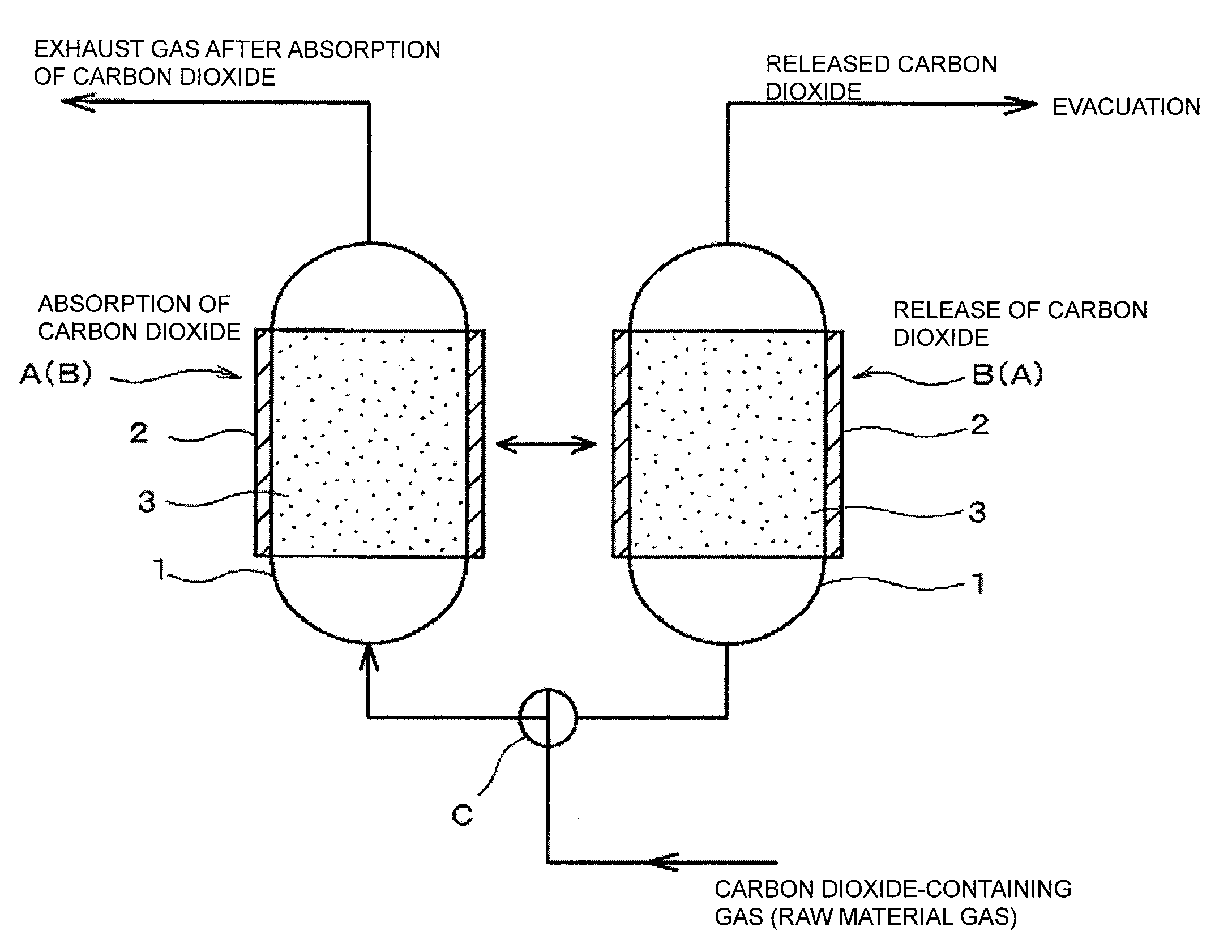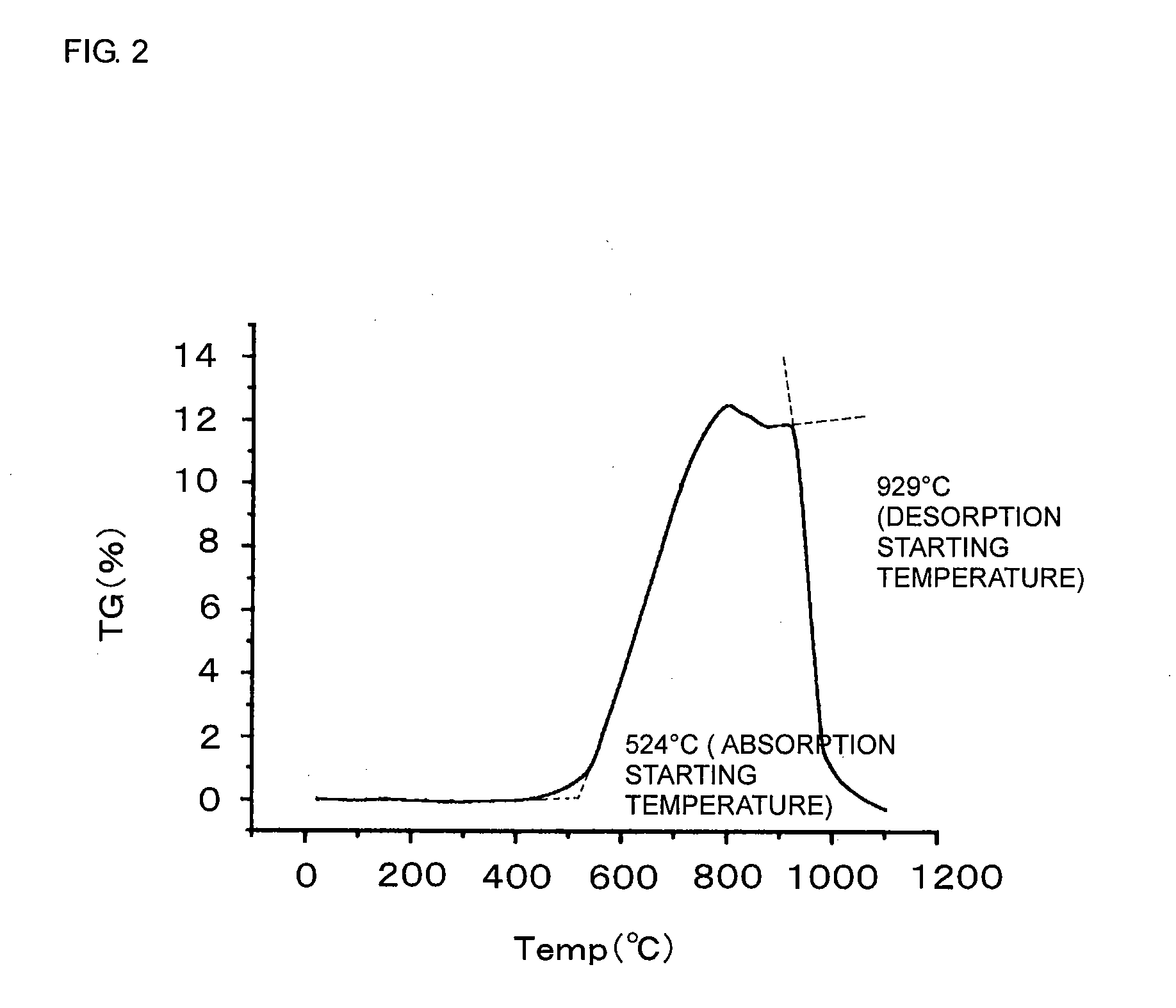Carbon dioxide absorbent and carbon dioxide absorption method using the same
a carbon dioxide and absorbent technology, applied in the field of carbon dioxide absorbent and carbon dioxide absorption method using can solve the problems of affecting the dielectric properties, the volume of lithium silicate varies, and the need for unnecessary parts cannot be reused, so as to reduce repetitive stress, increase the volume of the carbon dioxide absorbent, and efficiently absorb carbon dioxide
- Summary
- Abstract
- Description
- Claims
- Application Information
AI Technical Summary
Benefits of technology
Problems solved by technology
Method used
Image
Examples
example 1
[0054]A BaTiO3 powder, a BaCO3 powder, and a CaCO3 powder at a molar ratio of 2:1:2 and water were mixed in a ball mill for two hours. The resulting slurry was dried at 120° C. for 10 hours.
[0055]The resulting powder was fired at 1000° C. for two hours to produce a carbon dioxide absorbent (ceramic powder) according to an example of the present invention.
[0056]The ceramic powder was analyzed by X-ray diffraction. As shown in FIG. 1, the ceramic powder was mainly composed of a substance having a structure of Ba3Ca2Ti2O9.
[0057]The ceramic powder was also analyzed by thermogravimetric analysis-differential thermal analysis (TG-DTA) in a mixed gas atmosphere of CO2 and N2.
[0058]Heating rate: 10° C. / min
[0059]Atmosphere: N2 / CO2=80 / 20 (volume ratio)
[0060]As shown in FIG. 2, an increase in weight due to the absorption of carbon dioxide was observed at more than 500° C. The maximum absorption of carbon dioxide was 12.5 parts by weight per 100 parts by weight of ceramic powder (carbon dioxide...
example 2
[0065]A ceramic powder was synthesized as in Example 1, except that the molar ratio between the BaTiO3 powder, the BaCO3 powder, and the CaCO3 powder was 1:1:1.
[0066]The X-ray diffraction analysis of the ceramic powder showed that, although a hetero phase was partly formed, the ceramic powder was mainly composed of a substance having a structure of Ba3Ca2Ti2O9 as a main crystal phase.
[0067]The ceramic powder absorbed and desorbed carbon dioxide substantially in the same manner as the carbon dioxide absorbent in Example 1.
example 3
[0068]A ceramic powder was synthesized as in Example 1, except that the molar ratio of the BaTiO3 powder to the CaCO3 powder was 3:4 and BaCO1 was not used.
[0069]The X-ray diffraction analysis of the ceramic powder showed that, although a hetero phase was partly formed, the ceramic powder was mainly composed of a substance having a structure of Ba3Ca2Ti2O9 as a main crystal phase.
[0070]The ceramic powder absorbed and desorbed carbon dioxide substantially in the same manner as the carbon dioxide absorbent in Example 1.
PUM
| Property | Measurement | Unit |
|---|---|---|
| temperature | aaaaa | aaaaa |
| temperature | aaaaa | aaaaa |
| temperature | aaaaa | aaaaa |
Abstract
Description
Claims
Application Information
 Login to View More
Login to View More - R&D Engineer
- R&D Manager
- IP Professional
- Industry Leading Data Capabilities
- Powerful AI technology
- Patent DNA Extraction
Browse by: Latest US Patents, China's latest patents, Technical Efficacy Thesaurus, Application Domain, Technology Topic, Popular Technical Reports.
© 2024 PatSnap. All rights reserved.Legal|Privacy policy|Modern Slavery Act Transparency Statement|Sitemap|About US| Contact US: help@patsnap.com










